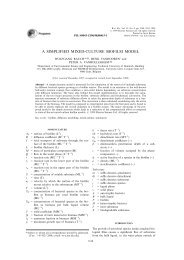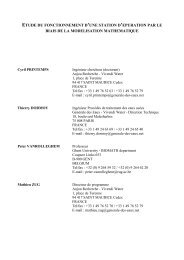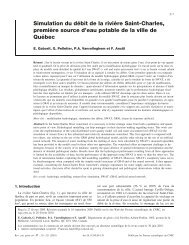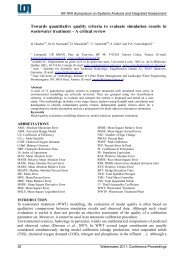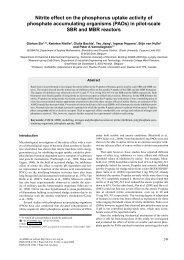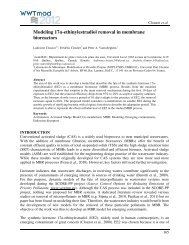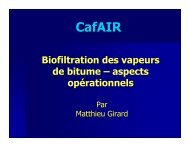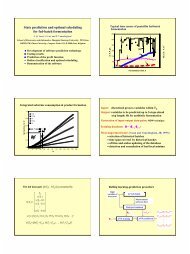Optimal control of the penicillin G fed-batch fermentation: An ...
Optimal control of the penicillin G fed-batch fermentation: An ...
Optimal control of the penicillin G fed-batch fermentation: An ...
You also want an ePaper? Increase the reach of your titles
YUMPU automatically turns print PDFs into web optimized ePapers that Google loves.
30 J. F. VAN IMPE ET AL.--I 1.z 1.4 IJS la 2 2.2 24 26 za 3c. 1-w ~10.3 LogldB)Figure 7. Left plot: T/U as a function <strong>of</strong> C, for various values <strong>of</strong> B. Right plot: optimal switch values for p and C,as a function <strong>of</strong> B with kh = 0The left plot <strong>of</strong> Figure 7 shows values <strong>of</strong> K/U as a function <strong>of</strong> C, for different values <strong>of</strong> B. Weconclude that for B = 0, T/U takes on its maximum value at C, = Cs.crit. 0Observe that for B = brit = lo-', K/U exhibits a (very smooth) maximum, corresponding toa finite value <strong>of</strong> Cs,switch. This is an additional verification that <strong>the</strong> optimal <strong>control</strong> in this caseis not a simple <strong>batch</strong> process while adding all available substrate (r at t = 0 as might have beenexpected. In <strong>the</strong> right plot <strong>of</strong> Figure 7 we show <strong>the</strong> optimal value for p and <strong>the</strong> correspondingvalue <strong>of</strong> C, (calculated using (18)) at which to switch from <strong>batch</strong> to singular <strong>control</strong> fordifferent values <strong>of</strong> B with kh = 0. Observe <strong>the</strong> convergence to p + brit and C, + Cs,crit whenB 0 as indicated by Theorem 1. These plots illustrate again that setting B = lo-" in (12) isa very accurate approximation <strong>of</strong> <strong>the</strong> original kinetics (3).In general, hydrolysis kh # 0, so we do not know <strong>the</strong> switch time tz in closed-loop form, i.e.as function <strong>of</strong> state variables only. However, <strong>the</strong> above <strong>the</strong>orem provides a good initial guessfor tz if kh is sufficiently small. It also indicates that during singular <strong>control</strong> <strong>the</strong> substrateconcentration will be time-varying. Obviously, for kh small <strong>the</strong> variations in C, with respectto t will also be small, as illustrated by <strong>the</strong> simulation results presented earlier.5.1. Suboptimal <strong>control</strong> strategies5. HEURISTIC CONTROL STRATEGIESIn this section we propose heuristic <strong>control</strong> strategies based on microbial and ma<strong>the</strong>maticalknowledge. We also indicate <strong>the</strong> conditions under which <strong>the</strong> suboptimal solution coincideswith <strong>the</strong> optimal one.In contrast with <strong>the</strong> optimal <strong>control</strong> approach, <strong>the</strong>re will be no need for partial derivatives.Thus <strong>the</strong> original model (B = 0) can be handled directly without any difficulty: as a matter <strong>of</strong>fact, <strong>the</strong> presence <strong>of</strong> a corner in <strong>the</strong> production kinetics (3) facilitates <strong>the</strong> design <strong>of</strong> asuboptimal <strong>control</strong>ler.From <strong>the</strong> microbiological and experimental point <strong>of</strong> view <strong>the</strong> construction <strong>of</strong> a suboptimalpr<strong>of</strong>ile can be based on <strong>the</strong> concept <strong>of</strong> a biphasic <strong>fermentation</strong> process.5.2.1. Growth phase [O, tz]. During <strong>the</strong> growth phase we focus on <strong>the</strong> specific growth rate



